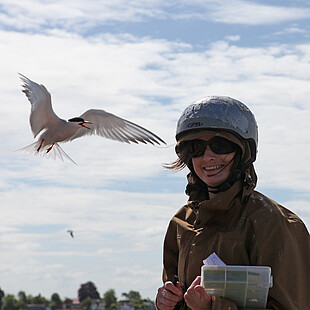Dr. Coraline Bichet
Research Interests
I am an evolutionary ecologist with research skills in population genetics and immuno-ecology, interested in patterns and processes both at the individual and population level.
At the individual level, I am interested to understand the effect of genetic parameters on fitness components such as survival, reproductive success and immunological parameters. I am also interested in the trade-off between survival, reproduction and immunity and how environmental and stress parameters could balance them. Moreover, I try to understand how environmental characteristics can act as a “vertical filter” on this trade-off.
At the population level, I mainly focus on how the environment can explain the origin and the maintenance of population genetic variability and how the individuals can cope with them, for example in terms of mate choice strategies.
Current project
My current work (started in August 2016) focuses on a long-term survey (24 years) of a common tern (Sterna hirundo) colony located in the Banter See on the German North coast. This long-term population study, which has also provided microsatellite genotypes and pedigrees, constitutes the perfect basis to study heterozygosity-fitness-correlations (HFC) using different fitness measures (survival, reproductive success) and across birds of different origin (immigrant/resident) or belonging to different age classes. I am also interested to explore which factors (as stress) can modify the trade-off between survival, reproduction and immunity. Hormonal stress measurements are developed and survival and reproduction data are already available. So, I would like, in the short-term, to measure different immune parameters (humoral, cellular and inflammation), as well as oxidative stress. In these long-lived sea birds, I also would like to investigate how anthropic factors (pollutants) can impact survival, reproduction and immunity and whether they can affect the life history trajectories of offspring.
Previous projects
During my three years (2009-2012) of PhD, I studied how the host, the environment and their interactions could influence the evolution of avian malaria parasites, using the house sparrow (Passer domesticus) and the domestic canary (Serinus canaria) as model species. The main finding of these studies is that parasite prevalence and parasitaemia develop independently. On the one side, prevalence depends on the environmental context, such as heavy metals levels (Bichet et al. 2013). On the other side, parasitaemia depend more on the characteristics of the host, such as age and sex (Bichet et al. 2013), or immune capacities (Bichet et al. 2012).
In the field of population genetics, I investigated how environmental characteristics (isolation) and parasitism (blood parasites) can explain the patterns of genetic variability and genetic differentiation observed in island and mainland populations of house sparrows at both neutral (microsatellites) and selected (MHC genes) genetic markers (Bichet et al. 2015).
Finally, I conducted a study to investigate how mate choice could be influenced by environmental constraints (isolation). I studied the reproduction of an insular population of house sparrows and found that females preferentially chose genetically related males. I also found a very high level of extra-pair paternity in this population and that extra-pair males were even more related to the female than the social male. This extra-pair mate choice seems to be adaptive, since extra-pair offspring had a better fledging success than within-pair ones (Bichet et al. 2014).
During my first post-doc (2014-2016), I used a long-term study of a population of Alpine marmots (Marmota marmota) to study the effect of genetic parameters (i.e. heterozygosity and relatedness) on fitness components (annual and lifetime reproductive success) using. I also investigated how climatic conditions can affect the occurrence of extra-pair mate choice (Bichet et al. submitted), and how sociality and age can affect individual stress and immunity levels. In addition, I managed a project to describe the genetic variability and differentiation of several Alpine marmot populations (Bichet et al. 2016), both native (from the French Alps) and reintroduced (from the Pyrenees). I found that Alpine marmot populations are strongly differentiated following an isolation-by-distance gradient in the Alps. The reintroduction caused a decrease in genetic variability in the Pyrenean populations, which showed multiple geographic origins. The fact that the reintroductions were conducted (by chance) from the most genetically diverse population of the Alps could explain the success of the establishment of the Alpine marmots in the Pyrenees.


